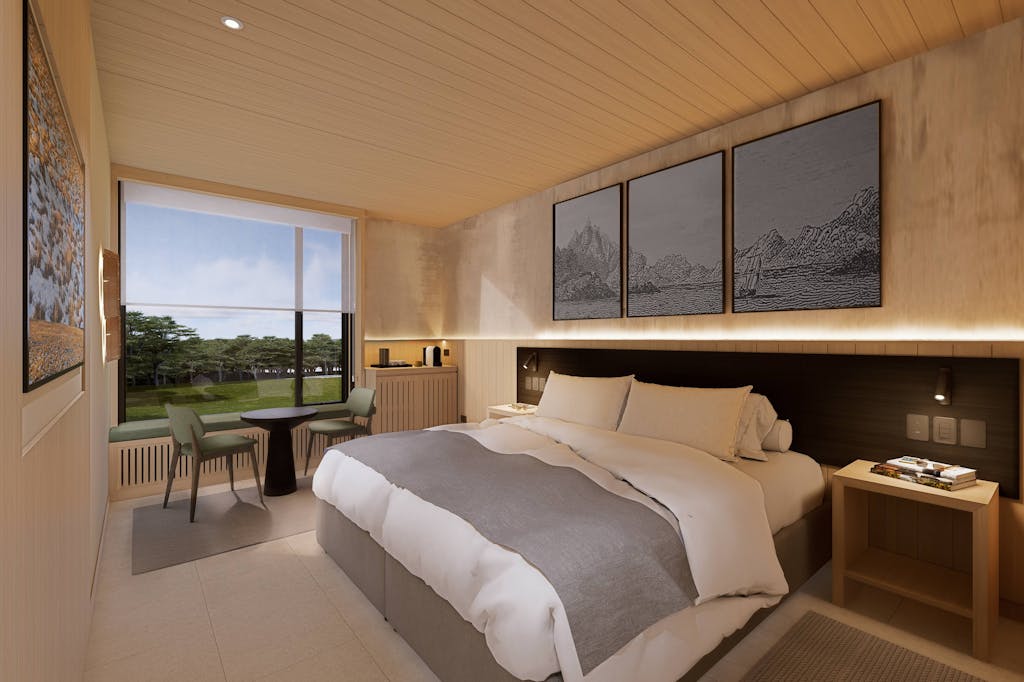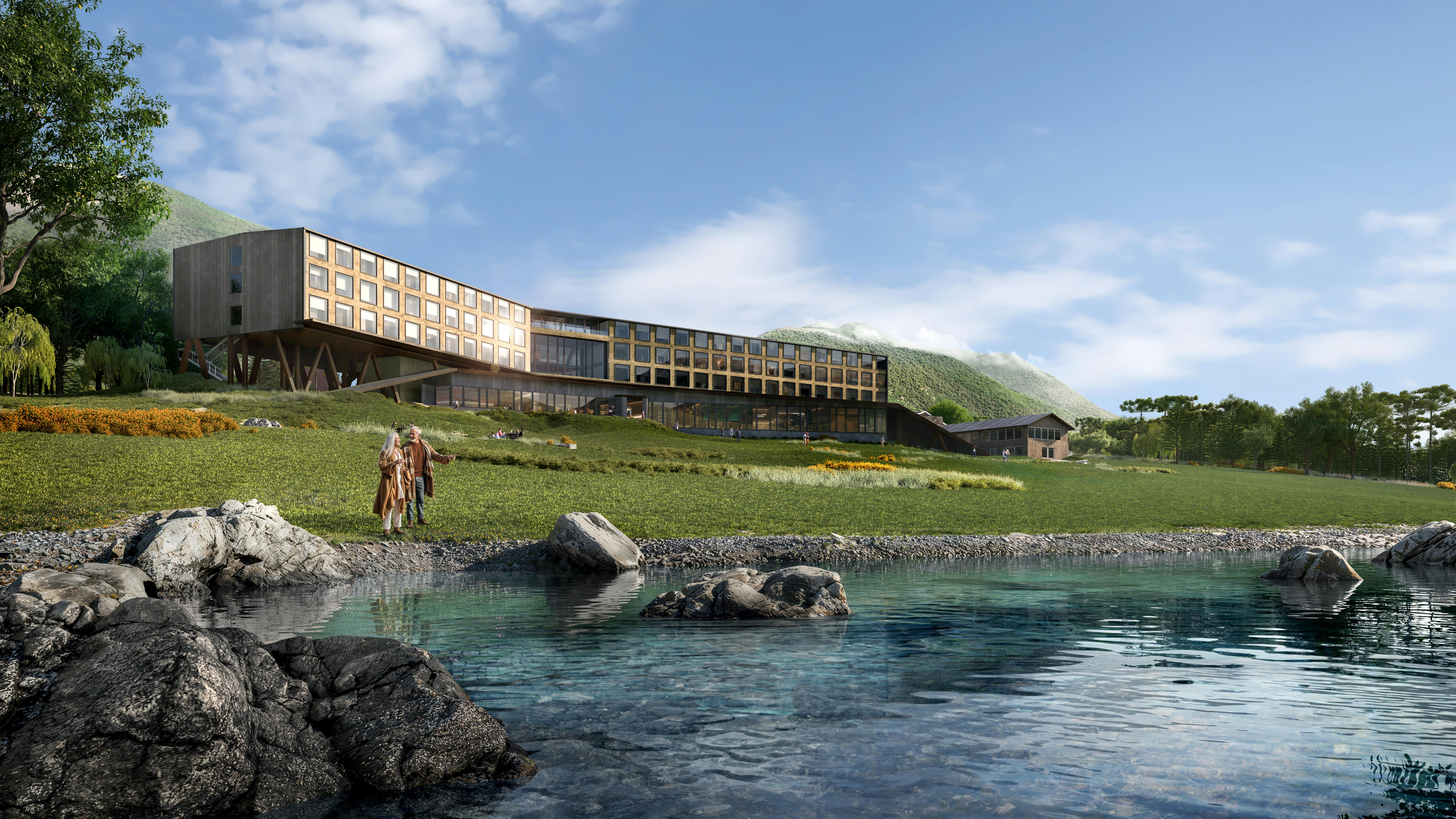Introducing the World’s Southernmost Hotel: The Cormorant at 55 South
I’ve been lucky enough to travel across the planet in multiple ways. I’ve foraged for inspiration in places as far-flung as the seat of a kayak in Greenland following a mother humpback and her calf, and on to the shores of far-flung, uninhabited islands in the Seychelles, where the population of land tortoises exceeds that of the Galapagos by a factor of ten.
My wanderlust has encouraged me to canvas the continents from one end to the other — that is, all but one. But it took only a few minutes chatting with Conrad Combrink, Silversea’s senior vice president of expeditions, destination and itinerary management, to know how I’ll go when I finally travel to my long-overdue seventh continent, Antarctica.
“Quite frankly, there’s something truly remarkable about the fact that you can get on a plane in South America, fly across the Drake Passage, and one hour and 45 minutes later you land in Antarctica,” Combrink says. “It’s a voyage that, 100 years ago, would have taken months. With the start of expedition cruising, it was two or three days to cross the Drake. Today we do it in under two hours.”
And now comes news that the journey will be even more seamless, as Silversea continues construction of a new, purpose-built 150-room hotel. When it opens in 2026, The Cormorant at 55 South will be the world’s southernmost hotel, built exclusively for Silversea’s guests, offering an amenity no other cruise line can brag about: a relaxing way station in a beautiful setting.
How did we get here?

Most expedition cruises to Antarctica have traditionally departed from the southern tip of South America, in Tierra del Fuego, an archipelago shared by Argentina and Chile. For years, the city of Ushuaia, Argentina, has been the homeport for expedition ships. As the terminus of the 19,000-mile Pan-American Highway, Ushuaia welcomes visitors with a shopping district and European-style architecture. But with a population of almost 83,000, perhaps Ushuaia doesn’t quite feel like a gateway to the bottom of the planet?
In 2022 Silversea made a big change, moving its Antarctica homeport to Puerto Williams, just 30 miles from Ushuaia, across the Beagle Channel and over the border in Chile. The line’s trio of ice-class expedition ships — 200-passenger Silver Endeavour, 254-passenger Silver Cloud, and 296-passenger Silver Wind — are now based here during the southern hemisphere summer, for the journey to Antarctica.
Puerto Williams is also, according to Combrink, a magnificent gateway.
After establishing Puerto Williams as its homeport, Silversea introduced the innovative Antarctica Fly Cruise, inviting guests to skip the two-day Drake Crossing by ship and transit by chartered plane to King George Island. On King George Island, a scientific research station, guests board their expedition ship.
“A big advantage is the fact that we’re the only company operating out of Puerto Williams, so we’re not competing for resources,” explains Combrink. “We control the journey because we’ve got charter flights and agreements in place. And, quite frankly, we don’t just allow for plan A — we plan for A, B and C. We’ve got a very, very clear standard operating procedure when things go wrong. And they do. But the teams have done a remarkable job at laying out not only how we execute when it goes according to plan, but also when it doesn’t go according to plan.”
The hotel will streamline the operation further, for weather in Antarctica and along the Drake Passage can force itinerary adjustments, often at the last minute. If weather presents delays to charter flights between Puerto Williams and King George Island, guests on the following cruise won’t have to cool their heels waiting in an airport terminal. They’ll be comfortably ensconced at Silversea’s The Cormorant at 55 South.
Lodging at the End of the Americas

Named after the majestic bird frequenting Tierra del Fuego and the latitude of Puerto Williams, The Cormorant at 55 South is designed to complement the seagoing experience by immersing guests in the destination, according to Ingrid Staudenmeyer, senior director, expeditions, who is responsible for developing the interior design and finishes for the hotel.
“We wanted to make this really authentic and representative of the location,” Staudenmeyer says. “The architect is locally based, and the design blends in with the environment, surrounded by trees in this very picturesque setting overlooking the Beagle Channel.” A snow-capped mountain range, the Dientes de Navarino, so named for its jagged pinnacles that resemble teeth, rises behind the hotel.
“Inside it’s very much a wood feel,” Staudenmeyer says, “with a lot of natural and earthy elements to reflect the surroundings. It’s very open, with high ceilings, and the color palette is more natural. We’re using a lot of artists from the area. As an example, they created these great lighting fixtures, and there will be a mural. From start to finish, it’s all about where are we and what can we showcase that’s truly authentic to the location.” All 150 rooms will be identical in size and layout, and there will be two views — one overlooking the Beagle Channel, the other offering a forest view.
Another way the hotel streamlines the Antarctica experience: Gear will be waiting for guests in their hotel room. “We provide the guests their parkas, waterproof pants, and boots,” Combrink says. “And then, if they need to adjust sizes, we’ll have the ability for them to do that downstairs, instead of on the ship.”
Drake Shake or Drake Lake?

Combrink suggests that the infamous Drake Passage is more bark than bite.
“It’s been built up in people’s minds to be something that it really isn’t,” Combrink says. “It can be quite rough, but the reality is that we have our own meteorologists monitoring weather systems around the world, helping determine the best and safest way throughout their voyage. If the Drake Passage is incredibly bad, we won’t be going through it.”
Choosing a Silversea voyage tied to the Antarctic Fly Cruise allows guests who don’t want to risk a rough passage the opportunity to fly. But there is something else that flying across the Drake saves: time.
“In developing the Antarctica Fly Cruise, we took into consideration guests that are a little bit more time constrained,” Combrink says. On a typical 10-day voyage, passengers spend four days crossing the Drake Passage, two heading south and another two days going north.
“There are travelers who don’t want to spend two weeks on an Antarctica journey because of the time that it takes to get there and back. That is the audience that we’re targeting. There’s also a younger audience because a lot of our guests are still working, and they don’t have as much time.”
I started my journey as a travel writer three decades ago. I’m no less adventurous or active than I once aspired to be, but today I’m in the latter stages of my career. These days, I feel as though the journey ahead is shorter than the one behind. As I consider the long list of places I haven’t explored, I’m starting to acknowledge that time is precious. Today, being there is becoming more important than getting there.
I’d still like to journey the Drake Passage. It seems like an essential crossing for anyone with a passion for cruising. But on the way back, why not fly across?
